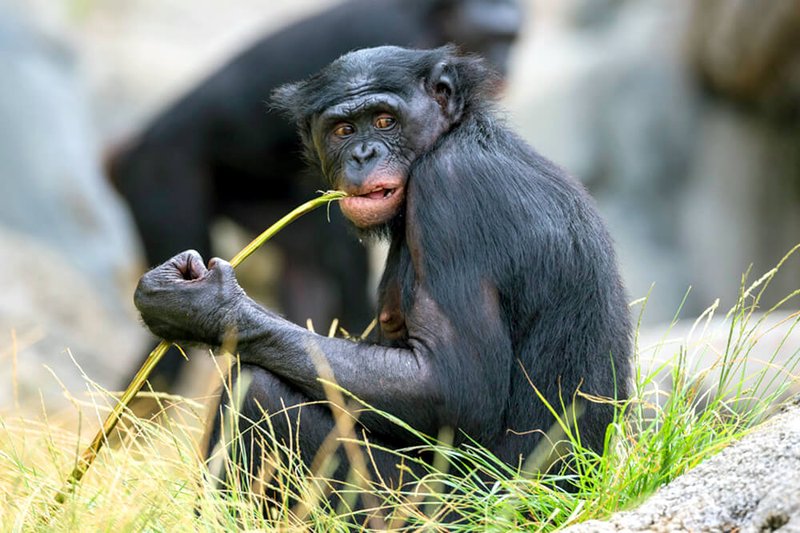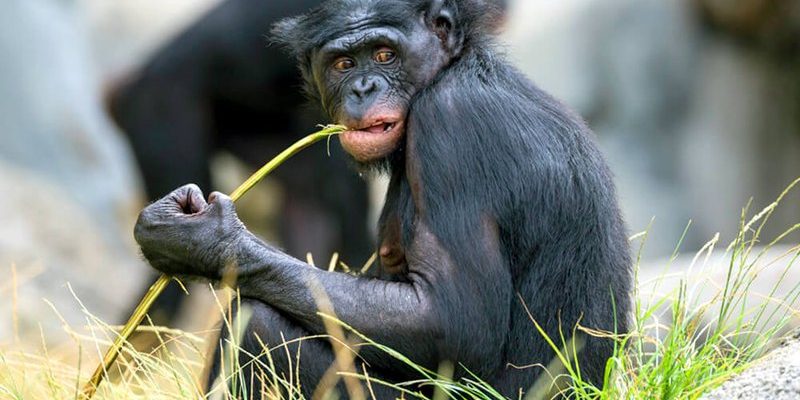
Bonobos live in the lush rainforests of the Democratic Republic of the Congo, where food sources are abundant but often require creative hunting strategies. They’re not just hanging around munching on bananas all day. These clever apes use various techniques to find food, showing off their intelligence and complex social behaviors. So, let’s dive into the diet and hunting strategies of bonobos and see what makes them so unique.
Understanding Bonobo Diet: What’s on the Menu?
Bonobos are omnivores, which means they eat a little bit of everything. You might be wondering what exactly does a bonobo eat? Well, their diet consists primarily of fruits, flowers, leaves, and sometimes insects or small vertebrates. Living in a rainforest full of biodiversity offers them plenty of options, so they get creative with their meals.
One of their favorites is *figs*, which they enjoy during certain times of the year when this fruit is in season. Imagine a picnic in your backyard with figs as the star dish. Bonobos often congregate around these fig trees, turning into little social gatherings. The more figs available, the more bonobos can be seen interacting, sharing, and feasting together. This isn’t just about food; it’s about building social bonds too.
They also rely on *vegetation* and *insects* as steady alternatives. During the dry season, when fruits become scarce, bonobos switch to eating leaves and roots. They sometimes engage in opportunistic hunting, but we’ll touch more on that in a bit. Their ability to adapt their diet depending on food availability shows their intelligence and flexibility in the wild.
Social Dynamics of Feeding
Here’s the thing: bonobos’ social structures play a massive role in their feeding behavior. Unlike many other primates that can be quite aggressive, bonobos are known for their peaceful interactions and strong social bonds. They often share food, which helps them maintain their relationships within the group.
When bonobos find a large fruit source, they don’t simply hoard it for themselves. Instead, they invite others to join in the feast. This behavior is essential for fostering friendships and alliances. By sharing food, they reduce competition and strengthen their social ties. It’s a bit like a potluck dinner—everyone brings a dish and, in turn, everyone benefits.
Notably, females tend to have a pivotal role in these social interactions. They often lead the way during feeding and can dictate when and where the group will eat. This matriarchal aspect of bonobo society highlights how their social structures influence their diets and hunting strategies.
Hunting: A Unique Bonobo Strategy
Now, let’s talk about hunting. Bonobos are not your typical hunters like lions or wolves. Instead of relying solely on brute force, they use a more *strategic approach*. They usually hunt small animals like monkeys or rodents, but this isn’t their primary food source. Instead, hunting takes a backseat to their foraging for fruits and plants.
What’s interesting is how they collaborate during hunts. Bonobos will often team up, using their social skills to coordinate efforts. They may rely on stealth and intelligence to catch their prey, similar to how a group of friends might strategize to win a game. This teamwork not only increases their chances of a successful hunt but also reinforces their social bonds.
In some cases, they might use tools, like sticks, to poke into tree hollows or disturb nests. This cleverness sets bonobos apart from many other primate species. Just picture a bonobo using a stick with the same finesse that a human might use a fork at dinner!
Factors Influencing Bonobo Hunting Strategies
Several factors shape how bonobos hunt. Their environment plays a significant role—living in dense forests provides ample cover but can make finding prey challenging. They tend to focus on areas rich in vegetation and fruit, which often coincide with their hunting grounds.
Seasonal changes also impact their strategies. During fruiting seasons, bonobos might not need to hunt as much since fruits are plentiful. However, when times get tough, their hunting tactics become more critical. They’ve adjusted their hunting behavior based on availability and environmental conditions, showing how adaptable they are.
Another crucial factor is competition. When other animals share their habitat, bonobos must be smart about how and when they hunt. They often have to outsmart not just their prey but also rivals who might be after the same meal. It’s a game of patience and strategy, much like navigating a big city to find the best restaurant.
The Role of Kinship in Hunting
Bonobos place a strong emphasis on kinship, and this affects their hunting strategies too. They are more likely to hunt with close relatives, which helps them maintain connections while hunting. Imagine heading out to a restaurant with your siblings instead of random friends; there’s comfort and understanding there.
When a group of bonobos goes out to hunt, they often rely on each other’s strengths. They’ll plan their approach based on who’s closest, who’s most skilled at climbing, or who can best spot hidden prey. This cooperation reflects the deep-rooted familial bonds that exist within bonobo communities.
Kinship doesn’t just affect hunting; it’s crucial for their overall social structure. Bonobos who have strong family ties are more likely to share food and engage in cooperative behaviors, which ultimately leads to stronger groups. In essence, their survival often hinges on their relationships.
Conservation and Its Impact on Diet and Hunting
Unfortunately, bonobos face numerous threats in the wild, such as habitat loss and hunting by humans. These factors can profoundly impact their diets and hunting strategies. When forests are cleared for agriculture or logging, bonobos lose their food sources and access to hunting grounds.
As their habitats shrink, bonobos may find themselves more frequently competing for the few resources left. This competition can lead to increased aggression and tension within groups, threatening their peaceful social dynamics. If they can’t find enough food, it may push them to engage in riskier hunting strategies, ultimately endangering their population.
Conservation efforts are crucial to protect their habitats and ensure bonobos have the resources they need to thrive. When we think about protecting bonobos, we’re not just saving a species; we’re also preserving a unique way of life that’s intricately connected to their diet and hunting practices.
The Takeaway: Why Understanding Bonobos Matters
Bonobos are more than just cute faces swinging through the trees; they are complex beings with intriguing dietary habits and unique hunting strategies. By understanding how they feed and hunt, we gain insight into their social structures and behaviors. Their ability to adapt their diet based on the seasons and their incredible cooperation during hunts reflect their intelligence and social connections.
As we work to protect bonobos and their habitats, we must recognize the vital role they play in their ecosystem. Protecting these remarkable creatures ensures we preserve not only their survival but also the intricate web of life they represent. So, the next time you think about bonobos, remember that their world is full of intricate relationships built around food, family, and survival.

